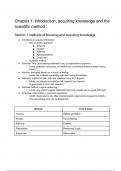Other
Book Notes- Research Methods for the Behavioral Sciences
- Course
- Institution
- Book
Book Notes- Research Methods for the Behavioral Sciences contains notes from most of the book, Chapters 1-9. 12, 13, 15,16. The book covers research methods on a deeper level than a normal book. The notes are for a graduate-level course but can easily be applied to any research class for the social...
[Show more]




